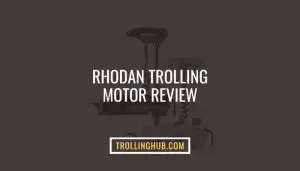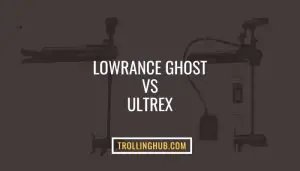Contrary to popular belief, fishing doesn’t just have to involve sitting on the edge of a lake, for hours on end to catch a small fry. Fishing can be much more exciting and successful for you if you try trolling.
Trolling is one of the most popular fishing techniques, where you drag a fishing lure through the water to make the fish think that the bait is moving prey. It makes the process more fun and increases the chance of you catching different types of fish.
A lot of people tend to think your trolling trip is dependent on luck. But with the right techniques and trolling speed, you can land a huge catch and impress everyone around you. Let’s get right into it
What Is Trolling Speed For Fishing And How To Measure It
Trolling speed refers to the speed of the boat or whatever moving water vehicle you are using to drag your fishing line through the water. Whether you are trolling in still water lakes with no current or a much more tumultuous environment like a river can heavily impact it.
Most people measure speed using GPS. While not very accurate, it can be a great tool for beginners. Speed can be an ambiguous term to use on the water since most GPS systems are built to calculate speed on the road.
However, GPS tools can help you out whether you’re a beginner or a more advanced fisher. You can pretty much get any cheap GPS out there to measure speed onboard.
There is also a trolling speed indicator that you can buy, that is designed specifically to measure trolling speed. These indicators are a sort of mechanical measurement system that uses a ball and a string to measure accurately up to 1/10 of a knot.
But these devices can be a little expensive and might not be great for people who are just starting to learn how to troll. There are also GPS-guided electric motors that you can get with your boat. These are a much more accurate way of not only measuring speeds but controlling them.
Does Trolling Speed Actually Matter?
Yes, trolling speed matters a lot in determining how well you succeed in your trolling trips. Each fish reacts differently to speeds. So finding the perfect pace can make all the difference in your trolling experience.
These diverse creatures have unique preferences when it comes to their prey. By mimicking the speed and movement of the ideal prey of whichever fish you are trying to catch, you can get them to bite your bait.
Faster speeds can often get a more aggressive reaction out of certain species and trigger them to bite on, while others like a more slow approach and follow the bait around before latching on. You can try different trolling speed knots yourself and see the difference.
How To Determine The Right Trolling Speed For You?
You can only determine the right trolling speed with experience. Each fish is different, and so is each water body. Several factors will determine the right trolling speed, including water currents, wind, temperature, the type of fish, and even your bait. So the best you can do is experiment with it.
Once you have found success, try to imitate the conditions for your next trips. Over time, you’ll get a good estimate of what works for you and what doesn’t.
How To Convert Trolling Speed From Knots To Mph?
A knot is a unit of speed that is used for sea or water speeds. It measures how many nautical miles per hour something is traveling. It’s the “water equivalent” of miles per hour on the road. The easiest way to convert knots to mph is to multiply the knots by 1.151.
But if you want a more accurate result, start by multiplying the number of knots by 6076, and then divide the answer by 5280. That’s your speed in mph.
What Is Considered High-Speed Trolling?
High-Speed Trolling usually refers to speeds above 15 knots up to about 20 knots. Such high speeds are usually used for Wahoo speed. The average trolling speeds are much slower at around 2-6 knots.
Depending on your conditions, your trolling speeds will vary. While high-speed trolling is exciting, slow trolling attracts a lot more types of fish.
Factors That Affect Trolling Speed
While the GPS on your boat will give you a measure of the speed the motor is running, several other factors affect the actual trolling speed. Here are some of them at a glance.
Boat
The obvious factor that will affect your trolling speed is what water vehicle you are using. People can also go trolling on rafts or even on stationary points. So how fast your boat is going will impact your trolling speed.
Trolling Motor
Whether or not you are using a Trolling Motor will affect your trolling speed. If the boat itself doesn’t have a motor then a trolling motor can help to push it around to keep the boat running allowing you to troll. You can also use the trolling motor to control trolling speeds more accurately.
Environment Conditions
Everything from the currents in the water body, to which direction you are going, how much wind there is to how much friction the bait is up against can affect your actual trolling speed. The environment your lure is surrounded by will affect the speed. So that’s why it’s important to gauge the speed yourself instead of relying on GPS.
Does More Thrust Mean Faster On A Trolling Motor?
No, more thrust does not always mean a faster speed on trolling motors. Thrust is a measure of the motor’s power and does not have anything to do with trolling speeds. A higher thrust means the motor will need higher voltages to run.
Thrust can make your boat run smoother and give better performance. It can impact the electric battery life. Usually bigger boats would require motors with a higher thrust.
Trolling Speed Chart For Different Fishes
| Fish Species | Best Trolling Speed |
| Trolling Speed For Tuna | Speed: 4.5- 7.5 knotsReason Why: Heavy lures can run deeper into the water column at these speeds, where you can find more tuna. |
| Trolling Speed For Trout | Speed: 1.3-2.2 knotsReason Why: Anything faster will scare the trout away. Trouts aren’t aggressive. |
| Trolling Speed For Mahi Mahi | Speed: 6.8-9 knotsReason Why: Mahi Mahi fish like excitement and lose interest at slower speeds. |
| Trolling Speed For Kingfish | Speed: 7-10 knotsReason Why: KIngfish aren’t picky. The right speed will depend on water conditions and depth. |
| Trolling Speed For Walleye | Speed: 1-3 knotsReason Why: Walleyes are more active in warm water and lethargic in winter. So slower speeds in spring will attract their attention while slightly faster speeds will get a reaction from when they are active in summer. |
| Trolling Speed For Spanish Mackerel | Speed: 5-7 knotsReason Why: The Spanish Mackerel is one of the most agile species in the ocean. |
| Trolling Speed For Wahoo | Speed: 8 – 18 knotsReason Why: Wahoos can swim at speeds of 60 mph, so you can go very fast to attract them. |
| Trolling Speed For Stripers | Speed:2.5-3 knotsReason Why: Stripers like slow motion so that they can lunge and swoop the prey. |
| Trolling Speed For Salmon | Speed: 1.5 – 2.6 knots Reason Why: Slower speeds allow the bait to sink to the Salmon’s depths. |
| Trolling Speed For Yellowfin Tuna | Speed: 6-7 knotsReason Why: Yellowfin Tuna like moving prey, so the bait should look like they’re swimming and not spinning. |
| Trolling Speed For Bluefin Tuna | Speed:4.5-5.5 knotsReason Why: Bluefin will start hitting at slower speeds, but can sometimes enjoy faster speeds. So start slow, and see what works. |
| Trolling Speed For Blue Marlin | Speed: 7.5 – 8.5 knotsReason Why: At these speeds, you’ll get the most catch at optimum sea conditions. |
| Trolling Speed For Bass | Speed: 1.7- 3.5 knots Reason Why: This allows the perfect depth for the lure to attract the Bass. |
| Trolling Speed For Lake Trout | Speed:1.3 – 2.1 knotsReason Why: Keeps the bait at about 30-60 feet deep, where Trouts bite. |
| Trolling Speed For Chinook Salmon | Speed: 1.3-1.6 knotsReason Why: Chinook Salmon can focus better on slower movements |
| Trolling Speed For Sharks | Speed:1.7-4.3 knots Reason Why: Slow trolling works best with Sharks as baits sink deeper. |
| Trolling Speed For Marlin | Speed:6.5 – 7.5 knotsReason Why: Marlins stop biting over 8 knots |
| Trolling Speed For Kokanee | Speed:0.6-1.6 knotsReason Why: Kokanee will usually follow your boat for a long time before biting on it. So slow trolling works best. |
| Trolling Speed For Crappie | Speed: 0.7-1.1 knotsReason Why: Crappies respond well to low and slow trolling. See what works best and change the speed. |
| Trolling Speed For Rainbow Trout | Speed:1.31-1.7 knotsReason Why: Rainbow trouts want to chase forage items and will follow the boat for a while before they do anything. So slow works better. |
| Trolling Speed For Coho salmon | Speed: 3-5 knotsReason Why: Coho salmons like faster speeds than other kinds of salmon. |
| Trolling Speed For Northern pike | Speed:1.5- 2.1 knotsReason Why: The right speed will depend on the kind of bait you’re using. Test out different ones from this range and see which works. |
| Trolling Speed For Sockeye salmon | Speed:0.6 – 1 knotReason Why: Sockeyes like slower speeds. So go as slow as you can. |
What Fish Do You Troll The Fastest?
Wahoos are one of the fastest fish you can find and you troll them at speeds as high as 18-20 knots. They are very aggressive and will almost bite at anything that moves fast enough, even if they aren’t hungry.
How Fast Do You Troll With A Plug?
You would usually troll at speeds of about 2.2 to 4.9 knots with plugs. Plugs are best trolled faster than baits. The type of plug you use can also affect how fast you should be going.
You can troll plugs on the surface of the water or you can use a downrigger to add some weight and sink it further. Try out different speeds within the recommended range and see what works best.
How Fast Do You Troll Spinners?
For spinners, the ideal trolling speed is 1 to 3 knots. Your speed will determine how fast the blade rotates on the harness. If you go too fast, it can ruin the effect of the spin. So slower speeds are best for trollers. But observe how the fish react and stick to that.
What Speed To Troll With Deep 6?
Deep Six divers work best at slightly faster speeds of about 3 knots or higher. They go very deep and can help you catch Kingfish and other species. Try out different depths, and see what works for you.
How Fast Do You Troll Crankbaits?
Crankbait trolling speeds are usually at about 1.3-2.6 knots. Depending on the circumstances, the speed can make a difference. So start slow and then go up to 2.6 knots to figure out what the fish is like.
What Speed Do You Troll Hard Body Lures?
The standard speed for Hard Body Lures is usually 5-8 knots, but you will master the right speed as you spend more time in the water. Some anglers even go for speeds of 2.5 knots with Hard Body Lures and it works for them. So it all depends on your circumstances.
Common Mistakes to Avoid
Now that we’ve gone over what to do, let’s check out a few of the things you shouldn’t do. Most beginners will make these mistakes.
Trolling too fast or too slow
Depending on your conditions, it can be hard to determine the right trolling speeds, especially for beginners. When you go too slow, certain fishes might not even notice your bait.
On the other hand, if you go too fast, they might not be able to catch up to you and hence can’t bite. So take your time and figure out which speed is optimum.
Not adjusting speed based on conditions
While you can find recommended trolling speeds for different fish online, you don’t always have to follow these rules. Each angler is different and troll on different conditions.
So be careful about the wind, the temperature, and even the current flow, and adjust speeds accordingly.
Not paying attention to fish behavior
The fish will tell you what they like. Observe as you tweak the settings and speed and see what they like. Once you’ve figured out what attracts the most fish, including rpm, type of bait, troll speed, etc, note them down and try to copy these conditions the next time.
Don’t ignore what the fish are doing, and just focus on manuals and speed indicator readings.
FAQs
A trolling plate will usually slow you down to about 0.8 to 1.7 knots.
A 40 lb thrust trolling motor is designed to go up to 3.4 knots, but it will depend on your boat and other factors.
</div>A 55lb trolling motor will go up to 4.34 knots on a kayak.
No, the maximum speed is 5 mph, no matter how high the thrust.
An 86lb thrust trolling motor can go up to 4.5 knots in trolling speed.
</div>Yes, they can allow a boat to go faster but it doesn’t make much of a difference.
An 18lb thrust trolling motor reaches speeds of up to 1.7 to 2.1 knots.
Trolling speed can affect lure depth, but it depends on the type of bait you are using. Slower speeds can allow the lure to go deeper. But in some cases, it doesn’t make much of a difference.
</div>The general rule of thumb while trolling is to set your drag setting to 20-25% of the breaking strength of the line.
Final Thoughts
Trolling is a great activity and many anglers do it regularly as a way to relax and have fun. It’s much more exciting than other forms of fishing and is great to impress beginners.
While many people think it’s simply a game of luck, things like currents and trolling speed affect your chance at success a lot. So with the right guidelines and enough practice, you can get great results at trolling.
<!-- CONTENT END 2 -->


